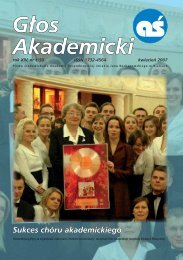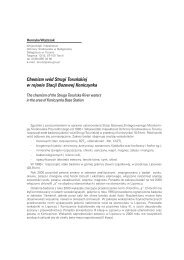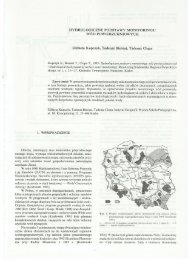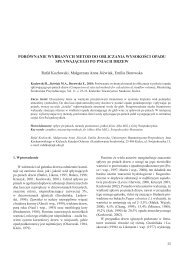25/2012 - Uniwersytet Jana Kochanowskiego w Kielcach
25/2012 - Uniwersytet Jana Kochanowskiego w Kielcach
25/2012 - Uniwersytet Jana Kochanowskiego w Kielcach
Create successful ePaper yourself
Turn your PDF publications into a flip-book with our unique Google optimized e-Paper software.
18 Janusz Sielski, Paweł Wałek, Agnieszka Janion-Sadowska, Marianna Janion<br />
The aim. The aim of the study is to provide a preliminary analysis of survival among patients after permanent pacemaker implantation.<br />
The present paper contains data regarding the numbers of implanted pacemakers in the Ward of Cardiology Świętokrzyskie Cardiac<br />
Center in Kielce for the years 1993–2009.<br />
Material and methods. We analyzed 7482 patients with permanent pacemakers implanted at one cardiac center in Poland between<br />
1993 and 2009. All the patients were registered in the Department of Pacemaker Checkups. Survival probabilities in patients with pacemakers<br />
were analyzed for men and women using the Kaplan-Meyer method. Gehan’s modified Wilcoxon test was used to test for the<br />
significance of differences between groups of patients with different types of pacemakers.<br />
Results. We implanted 787 (10.5%) AAI/R, 4031 (54.0%) VVI/R, 465 (6.2%) VDD/R and 2199 (29.4%) DDD/R pacemakers and<br />
performed another 1093 replacements. In women there were significant differences between VVI/R and DDD/R pacing (p < 0.001),<br />
between VVI/R and AAI/R pacing (p < 0.001), and between VVI/R and VDD/R pacing (p < 0.01). The highest and the lowest probability<br />
of survival was found in patients with VDD/R and VVI/R devices, respectively. In men there were also significant differences<br />
between VVI/R and DDD/R pacing (p < 0.0001), between VVI/R and AAI/R pacing (p < 0.001), and between VVI/R and VDD/R<br />
pacing (p < 0.05). The highest and the lowest probability of survival was found in patients with VDD/R and VVI/R devices, respectively.<br />
Similarly in the entire study group there were significant differences between groups with VVI/R and DDD/R (8.43 p < 0.001), between<br />
VVI/R and AAI/R (7,52 p < 0.001) and between VVI/R and VDD/R pacing (3.89 p < 0.01). The highest and the lowest probability of<br />
survival was found in patients with VDD/R and VVI/R devices, respectively.<br />
Discussion. We compared data on pacemaker implantation and survival times in patients treated in Kielce and other centers. Patients<br />
with VVI/R pacemakers have the lowest survival probability. In patients with DDD/R, VDD/R and AAI/R pacemakers survival suddenly<br />
worsens at about 6–9 years after implantation, which is especially visible in patients with AAI/R devices. For this reason patients<br />
with cardiac pacemakers should be checked up regularly to rule out late complications or to consider a change in pacing mode.<br />
Conclusions.<br />
5. In its 17-year history the study center has reached the national and European average number of cardiac pacemaker implantations.<br />
6. Pacing mode and age distribution of pacemaker patients is similar to that in other foreign centers.<br />
7. Preliminary survival analysis shows the highest survival probability in women and men up to 80 years of age with VDD/R pacemakers.<br />
8. The issue of patient survival after permanent pacemaker implantation warrants further analysis and discussion.<br />
Key wards: cardiac pacing, survival, implantation.<br />
WSTĘP<br />
Pierwszy rozrusznik serca został wszczepiony<br />
w 1958 roku w Sztokholmie przez prof. Ake Seninga<br />
u chorego z blokiem przedsionkowo-komorowym III<br />
stopnia [1]. Pierwsza implantacja układu stymulującego<br />
serca w Polsce została przeprowadzona przez<br />
prof. Zdzisława Kieturakisa w Gdańsku w 1963 roku<br />
[2]. W województwie świętokrzyskim pierwsze stymulatory<br />
zaczęto wszczepiać na Oddziale Kardiologii<br />
Szpitala Wojewódzkiego w <strong>Kielcach</strong> w 1993 roku.<br />
Od tego czasu znacznie udoskonalono zarówno<br />
stymulatory serca, jak i elektrody stymulujące. Rozszerzono<br />
również wskazania do stałej stymulacji<br />
serca. Obecnie obejmują one nie tylko zaburzenia<br />
przewodzenia przedsionkowo-komorowego i zaburzenia<br />
bodźcotwórczości, lecz także schorzenia,<br />
w których zaburzenia te nie występują (zespół zatoki<br />
szyjnej, omdlenia wazowagalne itp.). Współpraca pomiędzy<br />
inżynierią biomedyczną i kardiologią zaowocowała<br />
istotnym przeobrażeniem stymulatorów serca.<br />
Rozwinęły się nowe techniki na pograniczu stymulacji<br />
serca, takie jak kardiowertery-defibrylatory oraz<br />
terapia resynchronizująca [3].<br />
W 2009 roku w Polsce działało 113 ośrodków<br />
implantacji stałych stymulatorów serca, w których<br />
wszczepiono (łącznie z wymianami) 27 194 stymulatory<br />
serca (707 stymulatory na milion mieszkańców;<br />
tabela 1) [4]. Województwo świętokrzyskie zajmuje<br />
wysoką pozycję jeśli chodzi o liczbę wszczepionych<br />
stymulatorów. Na terenie województwa liczącego<br />
około 1,268 miliona mieszkańców działają 4 ośrodki<br />
implantujące stymulatory serca. W 2009 roku wszcze-<br />
Tabela 1. Liczba wszczepianych rozruszników serca oraz wymian<br />
rozruszników w Polsce w 2009 roku [4]<br />
województwo<br />
Wszczepienia/wymiany w 2009 roku<br />
liczba<br />
wszczepionych<br />
rozruszników<br />
(nowe +<br />
wymiany)<br />
liczba<br />
rozruszników<br />
na milion<br />
mieszkańców<br />
ośrodki<br />
implantacji<br />
mazowieckie 5260 1007 15<br />
lubuskie 827 819 3<br />
świętokrzyskie 1013 794 4<br />
dolnośląskie 2117 731 12<br />
opolskie 768 729 3<br />
POLSKA 27194 707 113<br />
śląskie 3374 703 15<br />
kujawsko-pomorskie 1427 690 6<br />
wielkopolskie 2372 668 13<br />
pomorskie 1463 667 8<br />
zachodniopomorskie 1056 623 5<br />
małopolskie 2018 620 8<br />
podlaskie 746 620 4<br />
łódzkie 1502 590 6<br />
lubelskie 1<strong>25</strong>2 579 3<br />
podkarpackie 1215 579 5<br />
warmińsko-<br />
-mazurskie<br />
784 549 3












